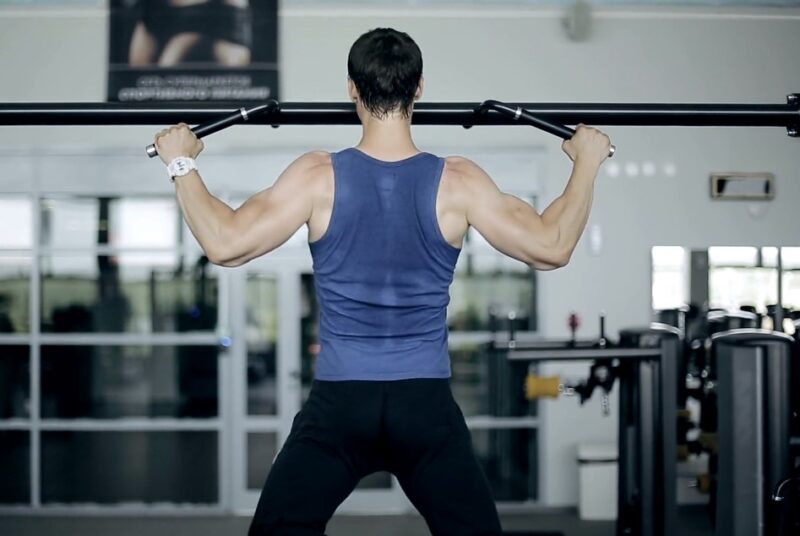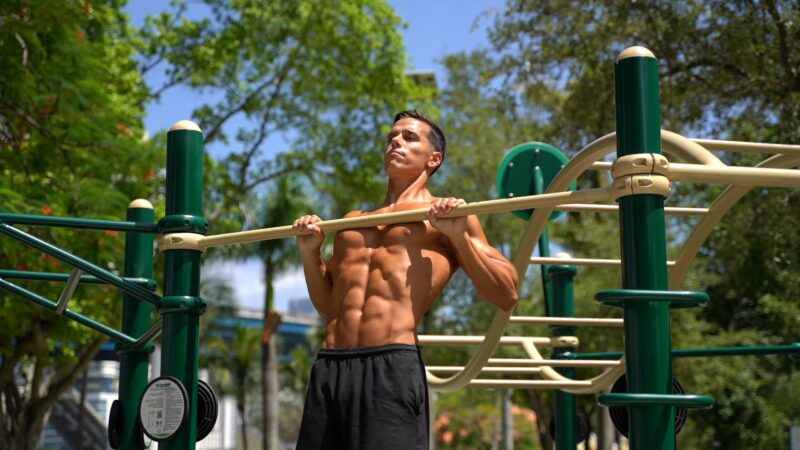Pull-ups, a seemingly simple exercise, have long been a benchmark of upper body strength and endurance. But when it comes to gymnasts, the standards are set sky-high.
Let’s explore the realm of gymnastics and challenge our comprehension by discovering the maximum number of pull-ups a gymnast can perform.
The Gymnast’s Physique
Gymnastics, a sport that marries grace with strength, demands more from its athletes than meets the eye. At the heart of this discipline lies the gymnast’s physique, a testament to years of dedication, training, and sheer willpower.

The Anatomy of a Gymnast
When you think of a gymnast, you might picture someone petite and agile. While agility is a crucial component, the strength aspect is often understated.
Gymnasts possess a unique combination of muscle density, lean body mass, and flexibility. This balance is what allows them to execute gravity-defying moves with elegance.
Strength and Endurance
Gymnasts are not just athletes; they are powerhouses. Their training regimen is holistic, targeting every muscle group.
While the focus on building strength is evident, it’s the type of strength they cultivate that’s noteworthy. It’s not just about lifting heavy weights but about functional strength—strength that allows them to control their bodies in various positions.
This functional strength is particularly evident in their upper body. The lats, biceps, and deltoids of a gymnast are not just for show.
These muscles undergo rigorous training, often bearing the gymnast’s entire body weight in routines. The result? A chiseled physique that’s primed for high-intensity activities like pull-ups.
Flexibility
While strength is a dominant factor, flexibility plays an equally vital role. The range of motion in their joints, especially the shoulders and hips, allows gymnasts to execute moves that seem almost otherworldly.
This flexibility, combined with their strength, means they can maneuver their bodies into positions most people can’t even fathom, let alone achieve.
Pull-Ups vs. Gymnastic Routines
To the untrained eye, a pull-up might seem like the pinnacle of upper-body exercises. And while it’s an excellent measure of strength, for gymnasts, it’s child’s play.
The World Beyond Pull-Ups
Gymnasts perform routines that demand not just strength but also balance, coordination, and precision. Activities on the rings, parallel bars, and high bars are complex, requiring a synergy of muscle groups working in tandem.
Take the Iron Cross on the Rings, for example. This move, where a gymnast holds their body out horizontally with arms extended, is not just about arm strength.
It demands a robust core, immense lat and deltoid strength, and impeccable balance. Compared to this, a standard pull-up seems elementary.
The Essence of Control
What sets gymnastic routines apart from standard exercises is the element of control. It’s not about brute strength but controlling that strength, channeling it into precise movements.
Every flip, twist, and hold is a testament to a gymnast’s mastery over their body.
So, How Many Can They Do?

The pull-up, a seemingly straightforward exercise, becomes a topic of intrigue when associated with gymnasts. Their exceptional strength and endurance naturally lead us to wonder: just how many pull-ups can these athletes perform?
The Range of Possibilities
While the average person might struggle to complete a set of 10 pull-ups, for many elite gymnasts, this is merely a warm-up. As mentioned, many can perform between 25 to 50 pull-ups in a single set.
But what’s even more astonishing is that some outliers, those who’ve dedicated additional focus to this exercise, have reported numbers soaring as high as 75 in a single session! However, it’s crucial to dive deeper into these numbers.
For gymnasts, the emphasis isn’t on merely racking up repetitions. Instead, it’s about the meticulous execution of each rep.
Their pull-ups are characterized by impeccable form, full extension of the arms, and a controlled ascent and descent. This precision makes their version of the pull-up far more taxing than the average person’s.
The Variables at Play

When evaluating the number of pull-ups a gymnast can perform, it’s essential to consider the myriad of factors that come into play:
1. Training Focus
Gymnastics is a multifaceted sport, with various apparatuses and routines. As such, not all gymnasts prioritize high-repetition pull-up training.
Their primary goal is to excel in their specific events, be it the floor, the pommel horse, or the uneven bars. Thus, their training regimens are tailored to enhance their performance in these events, which might not always align with maximizing pull-up repetitions.
2. Fatigue
The life of a gymnast is one of relentless training and constant pushing of boundaries. Their daily routines are grueling, often involving several hours of intense workouts.
So, if a gymnast has just wrapped up a demanding session on the rings or has been practicing their floor routine, their muscles might already be fatigued. This exhaustion can significantly impact their pull-up performance, reducing the number they can achieve in a single set.
3. Body Weight
Physics plays a role here. The force required to lift an object (in this case, the gymnast’s body) is directly proportional to its weight.
Therefore, lighter gymnasts might have a slight advantage when it comes to pull-ups. With less weight to lift, they can often achieve more repetitions.
However, it’s worth noting that while lighter gymnasts might have the edge in repetitions, heavier gymnasts often possess greater absolute strength.
Pushing the Limits: Beyond Numbers

In the realm of athletics, numbers often dominate the conversation. How fast? How many? How long?
Yet, when it comes to gymnastics, the story goes far beyond mere metrics. It’s about the heart, the spirit, and the relentless pursuit of excellence.
The Essence of a Gymnast
While the number of pull-ups or the height of a jump might capture attention, the true essence of a gymnast lies in their unwavering commitment to pushing boundaries. Every day, they challenge the very limits of what their bodies can achieve, often defying gravity and human expectations in the process.
Their journey is one of dedication and discipline. It’s waking up before dawn to train, spending hours perfecting a single move, and pushing through pain, fatigue, and setbacks. This sheer willpower, this indomitable spirit, is what sets gymnasts apart from the crowd.
The Human Potential
For most of us, watching a gymnast in action is awe-inspiring. Their feats seem almost superhuman, a testament to what the human body can achieve when honed to perfection.
Yet, it’s essential to realize that every gymnast started as a beginner, just like anyone else. Achieving even a fraction of a gymnast’s capabilities is a monumental accomplishment for the average person.
It serves as a reminder that with dedication, purpose, and passion, we can unlock incredible potential within ourselves. It’s not about innate talent but about the journey, the effort, and the heart put into every step.
FAQ
How do gymnasts’ pull-up numbers compare to non-gymnasts?
Gymnasts typically have a higher pull-up count compared to non-gymnasts due to their rigorous training and the necessity of upper body strength in their sport. While an average person might struggle to do 5-10 pull-ups, a gymnast’s training often allows them to exceed these numbers significantly.
Are there different types of pull-ups that gymnasts practice?
Yes, gymnasts often practice various pull-up variations, including wide grip, close grip, and mixed grip pull-ups. They also perform weighted pull-ups and L-sit pull-ups to increase strength and improve their skills on the apparatus.
How can I increase my pull-up count like a gymnast?
To increase your pull-up count, you can:
- Start with assisted pull-ups or negative pull-ups if you’re a beginner.
- Incorporate pull-up variations into your routine.
- Add weight gradually as you become more comfortable.
- Ensure proper form to prevent injuries and maximize efficiency.
- Train consistently and allow adequate recovery time.
Do female gymnasts perform as many pull-ups as male gymnasts?
While male gymnasts often have higher pull-up counts due to their natural upper body strength, many elite female gymnasts can also perform a significant number of pull-ups. The exact number varies based on individual training and strength levels.
Final Thoughts
Gymnasts stand tall among the pantheon of elite athletes, not just for their physical prowess but for their spirit. Their impressive metrics, like pull-up numbers, are just a glimpse into their world—a world where dedication, discipline, and passion reign supreme.
Their journey is a testament to the wonders of the human body and spirit. It’s a reminder that limits are meant to be pushed, boundaries are meant to be broken, and greatness is within reach for those willing to strive for it.
So, whether you’re an aspiring gymnast, someone passionate about fitness, or just embarking on your journey to a healthier self, let the world of gymnastics be your beacon. It’s not about the numbers you achieve but the heart you put into every effort. Embrace the journey, push your boundaries, and always strive for your personal best.
